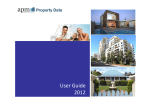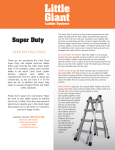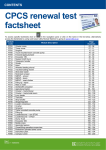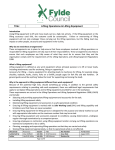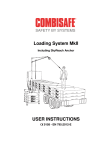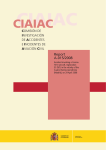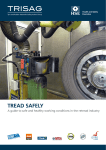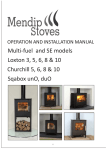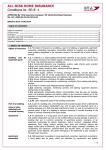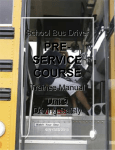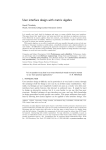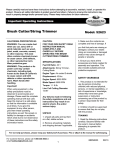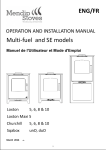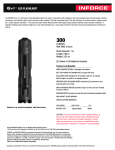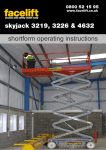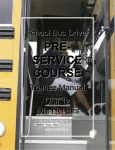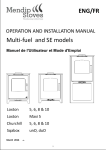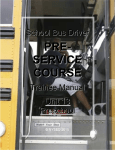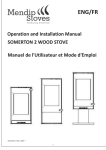Download PDF - Urban Planters
Transcript
Urban Planters Franchise Ltd. HEALTH & SAFETY POLICY © Copyright c/o Matheson & Horan Associates Limited. All rights reserved. Telephone 0161 428 9676. FOREWORD The business operations of the Company have the potential to harm people whether they are employees, inexperienced workers, sub-contractors or members of the public. In recognition of the various groups at risk this policy may be amended from time to time in the light of experience. IMPORTANT Employees should not be dismissive of any procedure in this policy that does not appear to be relevant to them. Some or all of the procedures may be relevant on a particular occasion. Therefore, employees should make frequent reference to this policy according to the business operations they are involved in, and in particular, the policy should be consulted prior to a new business operation being undertaken. The overall objective of the policy is that, as far as is reasonably practicable, employees are able to work in a safe environment. To achieve that objective the management will appreciate the assistance of all employees and requests that, at all times, all employees consider the health & safety welfare of fellow employees, inexperienced workers, subcontractors and members of the public. NB Any regulation referred to in this policy is liable to be amended or replaced. Where such amendments or replacements occur they are to automatically apply to this policy and the Company will endeavour to amend this policy as soon as is reasonably practicable after the Company is aware of such amendments or replacements. © Copyright c/o Matheson & Horan Associates Limited. All rights reserved. Telephone 0161 428 9676. CONTENTS 1. Health and Safety General Policy Statement of the Company 2. HEALTH AND SAFETY POLICY 3. On Site and Off Site Working 4. Responsibilities of employees 5. Responsibilities of the Health & Safety Officer 6. Communication 7. Co-operation & Care 8. Safety Training 9. Inspections in the Workplace 10. Substances Hazardous to Health 11. COSHH Precautions 12. Environmental Policy 13. New or Expectant Mothers 14. Personal Protective Equipment Regulations 15. Equipment Regulations 16. Vehicles, Plant & Machinery in General 17. Electrical Appliances 18. Asbestos 19. What to do if you discover or encounter Asbestos 20. Security 21. Display Screen Equipment 22. Mobile Phones 23. Fire Safety Regulations 24. Fire Safety Officer 25. General Fire Procedures 26. Fire Detection Equipment 27. General Fire Alarm 28. Other Emergency Procedures 29. Fire Escape Routes 30. Fire/Evacuation Emergencies on Client Sites 31. Fire Fighting Equipment 32. Fire Doors 33. Fire Exits 34. Lifts 35. Smoking 36. Accident Investigation & Reporting 37. First-Aid 38. Accident Procedure 39. First-Aid Boxes 40. Travelling First-Aid Kits 41. Supplementary Equipment 42. General Guidance Card on First-Aid 43. General Office Safety 44. Housekeeping 45. Hygiene & Health Conditions 46. General Procedures 47. Walkways and Passageways 48. Welfare Facilities at Client Sites 49. Lone Working Procedures for Employees 50. Tools Equipment and Machinery 51. Hand Arm Vibrations (HAVs) 52. Noise 53. Manual handling Operations 54. Personal Protective Equipment Regulations © Copyright c/o Matheson & Horan Associates Limited. All rights reserved. Telephone 0161 428 9676. 55. Equipment and Operations 55.1 Safety Helmets 55.2 Safety Footwear 55.3 Eye Protection 55.4 Hand Protection 55.5 Lifting Operations and Lifting Equipment 55.6 Lifting Appliances 55.7 Lifting Slings 55.8 Working at Height 55.9 Stepladders / Trestles / Ladders 55.10 Mobile Scaffold Towers 55.11 Mobile Working Platforms (MEWPs) 55.12 Scaffolding 55.13 Safe Access/Egress 55.14 Responsibilities of sub-contractors 56. Additional Clause (if applicable) © Copyright c/o Matheson & Horan Associates Limited. All rights reserved. Telephone 0161 428 9676. 1. Health and Safety General Policy Statement of the Company Important: All employees must read this statement and be familiar with the Company’s policies. The term “firm” or “company” also means “partnership” or “proprietor”. It is the policy of the Company to comply with the obligations under the Health and Safety at Work Act 1974 (as amended), the Management of Health and Safety at Work Regulations 1999 (as amended) and if applicable any other supporting legislation concerning Health and Safety. At all times the Company will endeavour to provide and maintain a healthy and safe working environment for its employees as well as to take steps to protect the health and safety of all visitors to the company, including contractors from other firms and temporary workers, as well as any members of the public who might be affected by our operations. The overall objective of the Company‟s health and safety policy is to minimise the number of instances of occupational accidents and illnesses. The ultimate objective is not to have any such instances. The Company will endeavour to do all that is reasonably practicable to ensure the health and safety of its employees, however, health and safety at work is the responsibility of each and every individual associated with the company. Everyone requires constant vigilance and concern for the welfare of others. It is also the duty of each employee to take reasonable care of his or her own welfare and to report any situation, which may pose a threat to the well-being to himself or herself or any other person. Such hazards in the workplace such as frayed electrical cables, dangerously defective equipment, unsafe structures, possible fire risks, loose floor tiles etc should be reported as a matter of routine and no member of staff will be penalised for complaining if such hazards are not rectified by the management or designated Safety Officer. It is therefore every worker‟s responsibility to report immediately any situation that could endanger the wellbeing of them or others and the reporting of injuries, however small, sustained by a person at work must never go unrecorded. Accident records are crucial to the effective monitoring and revision of the Company policy and must therefore be accurate and detailed. The Company believes that the success of its Health and Safety Policy can only be achieved through the cooperation of all personnel. Experienced employees must have due regard for inexperienced employees by not allowing those inexperienced workers, especially young workers, to unknowingly put their health and safety at risk. On the other hand, an inexperienced worker (despite prior training) or an untrained worker should not attempt to do hazardous work if they do not feel competent or have not been trained for such work. If any inexperienced or untrained worker is in any doubt about his or her competence in carrying out hazardous work they must immediately cease to do such work and inform their immediate supervisor or Safety Officer. Employees will be provided with the required equipment, information, training and supervision as is necessary to implement the Company‟s health and safety policy. The Company‟s health and safety policy will be continually monitored and improvements to the policy will from time to time be implemented. The Company invites all employees to put forward any suggestions for improvements, or complaints, regarding the health and safety policy either informally or in writing directly to the designated Safety Officer. Signed: Urban Planters Franchise Ltd Job Title: Franchise Director Date: 01.05.15 © Copyright c/o Matheson & Horan Associates Limited. All rights reserved. Telephone 0161 428 9676. 2. HEALTH AND SAFETY POLICY (Important: All employees must make themselves familiar with this policy) 2.1 The person responsible for the overall health and safety policy of the Company is: Name: Alan Page Title: Franchise Director Company Name: Urban Planters Franchise Ltd Address to write to: The Granary, The Stables Business Park, Bristol Road, Rooksbridge, BS26 2TT 2.2. The designated Health & Safety Officer of the Company is: Name: Alan Page Title: Franchise Director Company Name: Urban Planters Franchise Ltd Address to write to: The Granary, The Stables Business Park, Bristol Road, Rooksbridge, BS26 2TT 2.3. First aid kits are supplied and located as follows: First Aid Box - Store Cupboard 2.4. Personnel appointed as First Aiders are as follows: Alan Page Rachael Furneaux 2.5. The designated Fire Safety Officer of the Company and the person responsible for the maintaining and testing of fire alarms, detection equipment and fire-fighting equipment is: Name: Alan Page Title: Franchise Director Company Name: Urban Planters Franchise Ltd Address to write to: The Granary, The Stables Business Park, Bristol Road, Rooksbridge, BS26 2TT 2.7. The designated assembly points for fire and emergencies are: The Disabled Parking Area within the Main Car Park 2.8. Location of Fire Fighting Equipment DEPARTMENT Main Office Main Office EQUIPMENT CO2 Gas / Water © Copyright c/o Matheson & Horan Associates Limited. All rights reserved. Telephone 0161 428 9676. 3. On Site and Off Site Working If work is carried out on behalf of the Company off-site on clients‟ premises, employees must be aware that when working on client premises the client has the overall legal responsibility for the health and safety of all personnel whether such personnel are client‟s employees, sub-contractors or members of the public. Therefore, employees of the Company must familiarise themselves with the health and safety procedures of our clients when working on their premises and employees are instructed to fully comply with the health and safety procedures of any clients as well as complying with safe working practices contained in this policy and/or any instructions given by any On-Site Health and Safety Officer or Team Leader appointed by the Company. Employees should address any immediate concerns with regard to health and safety to the respective clients when working on their premises and/or any On-Site Safety Officer or Health & Safety Officer of the Company if those concerns are not addressed. Regardless of where employees work, employees of the Company are responsible for safe-working practices at all times and this document sets out the Company’s policy and principles as to health and safety procedures. 4. Responsibilities of employees All employees, irrespective of status, have a personal responsibility with regard to Health & Safety as follows: To be familiar with the Company's Health & Safety Policy and with the standards and procedures it contains and to co-operate and implement its contents. To understand and comply with all instructions, working procedures and safety rules which apply to their work. Some rules have a general application, like those pertaining to fire risks and emergencies. Other rules pertain to specific jobs and equipment; for example, those relating to driving fork lift trucks, correct use of lifting equipment and the safe means of access/egress etc. To work with due care and attention at all times. Whilst it is the management's responsibility to provide and maintain the necessary equipment for safe working, it is equally the employee's responsibility to use that equipment properly, and in many cases there is a legal obligation to do so. Not to operate plant, tools or equipment unless the employee is trained and authorised to do so. To wear or use personal protective equipment as instructed or when circumstances dictate its use. To report any hazards seen and, if appropriate, make suggestions for their elimination and control. To report any defects in plant, tools or equipment. To ensure their work area is kept clean and tidy. To develop a personal concern for the safety of themselves and others. To report all accidents, injuries, dangerous occurrences and 'near misses' no matter how trivial they may seem. To raise any safety matter with the appropriate person. 5. Responsibilities of the Health & Safety Officer The Company Health and Safety Officer has the delegated overall responsibility for all health, safety and welfare matters within the organisation and will report to the most senior official and/or the board of directors of the Company as required by them. He will ensure that there is an effective policy for health and safety, the provision of regular reviews to its efficiency and the provision of adequate staff, funds and materials to meet the policy‟s requirements. He will ensure: That responsibility for safety is properly assigned and accepted at all levels. That arrangements are made for the provision of suitable and sufficient safety training for all employees. © Copyright c/o Matheson & Horan Associates Limited. All rights reserved. Telephone 0161 428 9676. That personnel are informed of any relevant changes to health and safety documents and are up-dated as necessary. That health and safety monitoring is regularly undertaken at all sites where the company is operating. To ensure all relevant health and safety matters are discussed with prospective clients and to liaise with clients and building occupiers over health and safety arrangements and implement such arrangements. That information is obtained from suppliers on the safe use of plant, equipment and materials and that all relevant health and safety information and guidance are provided to employees as required. That records of statutory inspections and other appropriate records are kept. That records of injuries and work-related diseases are maintained and that appropriate reporting action is undertaken. That appropriate resources are allocated to allow for the elimination and/or control of known hazards and to safeguard against the introduction of new risks. That sub-contractors tenders include adequate provision for safe working. To co-ordinate the work of sub-contractors and liaise with main contractors where applicable. That appropriate health and safety arrangements are made with clients and building occupiers and that relevant matters are taken into account when submitting tenders. To ensure that employees are only allocated work according to their ability, and that they have been given the appropriate instructions and/or training to enable them to carry out their work in a safe manner. To ensure only trained, competent and authorised personnel use plant, tools and equipment and that young or inexperienced worker are properly supervised. The provision of suitable plant and equipment necessary to ensure safe access, safe working or ease of handling including the requirements for any specialised safety and storage equipment. To check that new plant and equipment meets any relevant health & safety standards before it is purchased. To provide risk assessments and maintenance schedules on plant and equipment as necessary. The provision of adequate welfare and first aid facilities. To ensure that all accidents are reported and recorded, and that attention given by medical or first aid staff is appropriate. To investigate, report, and find the cause of, all incidents/accidents on the site, including those, which result in only minor injuries, or cause loss or damage to plant or materials with no injury and to take appropriate remedial action to prevent re-occurrence. The action to be taken in the event of fire or other emergency and the provision of suitable fire fighting equipment. Consider the protection of the public when carrying out risk assessments and implementing preventative health and safety procedures. To carry out risk assessments of any hazards, which could arise and determine the most appropriate order and method of working and record such assessments. To this end he will liaise with employees, clients and building occupiers over health and safety arrangements. To monitor health and safety procedures to ensure that all directly employed personnel and employees of sub-contractors operate in accordance with any legal requirements and Company policy. Check that new less hazardous substances can be purchased in preference to more hazardous substances harmful to health. To identify substances which need a COSHH assessment and undertake the assessment and ensure that all actions identified in the assessment(s) are implemented. To ensure that all relevant employees are informed about COSHH assessments. COSHH assessments will be reviewed prior to the purchase of new substances, when work activity changes or as required. To carry out, monitor and review appropriate fire risk assessments and, if a Fire Safety Officer is appointed, to supervise the Fire Safety Officer‟s activities. The provision of all necessary items of personal protective equipment, safety signs and relevant health and safety documentation and to ensure that safety equipment and all personal protective equipment needed for each operation is provided and is readily available, and that such personal protective equipment is used or worn as appropriate. To ensure that materials are stored safely and that, where appropriate, fire fighting equipment is readily available. To ensure all scaffolds, cradles, working platforms etc, are properly erected and safe before allowing them to be used by personnel within their control. © Copyright c/o Matheson & Horan Associates Limited. All rights reserved. Telephone 0161 428 9676. To ensure that cleanliness, tidiness and all that contributes to 'good housekeeping' is of an acceptable standard. To take prompt corrective action whenever unsafe acts are noticed or reported to them. NB. If the Health & Safety Officer delegates any of the above responsibilities he must ensure that such delegation is given to a competent person. However, the delegated competent person will remain under the continuous supervision of the Health & Safety Officer. 6. Communication The Company will endeavour to ensure that employees are familiar with the contents of the Company health and safety policy and will communicate and consult with an elected representative of the employees or directly with employees orally, through supervisors, or in writing, in the form of directives and this policy. The Company will also consult and liaise with a union appointed safety representative of any trade union recognised by the Company on matters affecting employees that the union represents. 7. Co-operation & Care Employees are expected to co-operate with the Health & Safety Officer and to accept their duties under this policy. Disciplinary action may be taken against any employee who violates safety rules or who fails to perform his or her duties without regard to this policy. 8. Safety Training Safety training is essential for all effective health and safety procedures. All workers will be trained in safe working practices and procedures relevant to their duties. Training will also include advice on the use and maintenance of personal protective equipment, if applicable. Training sessions will be held as often as is deemed necessary. Despite training sessions, employees can raise concerns regarding health and safety training at any time with their immediate supervisor or directly to the Health & Safety Officer. 9. Inspections in the Workplace The Company will endeavour to comply with current regulations on matters such as workplace stress, noise, ventilation, heating, lighting, workstations, seating and welfare facilities. This requires regular inspections of the workplace from time to time. Inspections will be of a routine nature or as a result of an event or a planned change in working procedures. Inspections will always provide the opportunity to review the continuing effectiveness of safe working practices and implement changes where necessary. 10. Substances Hazardous to Health - Introduction The Company will comply with the Control of Substances Hazardous to Health Regulations 2002 (COSHH) (as amended). Risk assessments will be undertaken of all work involving exposure to hazardous substances. The Company will ensure that exposure of workers to hazardous substances is minimised and controlled. Employees who will come into contact with hazardous substances will receive training and information on the health and safety issues concerning such substances. Employees working with hazardous substances must follow Company procedures relating to the substances. Employees must assume that all workplace substances are hazardous to health unless proved otherwise and you must abide by all the hazard information provided on Assessment Sheets and/or manufacturers ’ instructions. If you are in doubt about a substance or its method of use ask the Health & Safety Officer. © Copyright c/o Matheson & Horan Associates Limited. All rights reserved. Telephone 0161 428 9676. Substances hazardous to health are any natural or artificial substances (including micro-organisms), which can be toxic, harmful, corrosive or irritant to any employees exposed to them. In the event of contamination, the employee should find out the substances and its source and, if injury occurs he/she should contact the First-Aider, his/her own doctor or the Local Hospital (Casualty Department) for treatment without delay. 11. COSHH Precautions Under the Control of Substances Hazardous to Health Regulations 2002 (COSHH) (as amended) the following precautions should be taken: Handle hazardous substances with care and use the personal protective equipment supplied as it is supposed to be used. Make sure you are familiar with the rules (e.g. COSHH) for using substances. (Refer to COSHH Assessments). Before eating, drinking and smoking it is very important to ensure that hands are washed. Remove lids/stoppers only when the substance is to be used. Store highly flammable substances as per manufacturers/suppliers recommendations. Use only minimum quantities of a hazardous substance required for immediate use. 12. Environmental Policy The Company and its employees have a duty to act responsibly towards customers, staff, suppliers and the public with regard to the effect that business operations may have on the environment and will endeavour to achieve its responsibilities through the following objectives: To adhere to any current legislation and where possible and to anticipate new requirements and set out new procedures as required. Where possible, to purchase from suppliers who share concern for the environment and whenever possible to produce products from sustainable sources. To minimise waste from business operations and where possible to reduce, re-use or recycle waste. To endeavour to control the level of harmful emissions whenever practicable. To promote the use of energy efficient systems in business premises. To support organisations that promotes environmental protection issues. The Company will continue to monitor, evaluate and improve its performance whilst promoting environmental awareness to employees. 13. New or Expectant Mothers A risk assessment will be carried out in respect of risks to new or expectant mothers. Where risks to new or expectant mothers are identified, adjustments to working conditions may be made to avoid such risks. Where adjustments are not possible, and no alternative work can be found, the new or expectant mother will be suspended from work on full pay. 14. Personal Protective Equipment Regulations The Company will comply with the Personal Protective Equipment at Work Regulations 1992 (as amended). This requires that all employees who may be exposed to a risk to their health and safety while at work will be provided with properly fitting, suitable, and effective personal protective equipment or clothing. © Copyright c/o Matheson & Horan Associates Limited. All rights reserved. Telephone 0161 428 9676. All personal protective equipment or clothing provided by the Company will be maintained in good working order and all employees provided with such protective equipment or clothing must wear or use such protective equipment properly. Employees must report defective personal protective equipment or clothing to their immediate supervisor or Health & Safety Officer as soon as it is found to be defective. Employees provided with personal protective equipment will receive training and information on the use, maintenance and purpose of the equipment. 15. Equipment Regulations The Company will comply with the law as set out in the Provision and Use of Work Equipment Regulations 1998 (as amended) and will try at all times to ensure that all equipment used in the workplace is safe and suitable for the purpose for which it is used. Employees will be provided with adequate information and training to enable them to use relevant equipment safely and such equipment must only be used by such authorised and trained employees. Work equipment must be maintained in good working order and repair. Employees must report defective work equipment to their immediate supervisor or Health &Safety Officer as soon as it is found to be defective. 16. Vehicles, Plant & Machinery in General Only authorised and, if applicable, certificated, drivers and operators may use any vehicles, plant or machinery. Users of any vehicles, plant and machinery must ensure that such equipment is in good working order and well maintained. (Defects must be brought to the attention of the Health & Safety Officer immediately). Regular inspections appropriate to each vehicle plant and machine must be made and any defects brought to the attention of the Health & Safety Officer. Unsafe, faulty or unsuitable vehicles, plant or machinery must not be used and should be immobilised until made safe. Official notices or instructions on vehicles, plant and machinery must be obeyed. Vehicles, plant or machinery must not be left running whilst unattended and if unattended must be left in a safe place and condition. All guards must be kept in position at all times whilst machinery is being operated. Defects must be brought to the attention of the Health & Safety Officer immediately. No equipment must be used beyond the marked safe working load, except for the purpose of testing, which must be supervised by a competent person. All loading gates must be kept closed, except where loading or off-loading is in progress. Only trained and authorised personnel may operate any woodworking machine. On the completion of work for the day all practical steps must be taken to secure all vehicles, plant and machinery. It is forbidden for any person to ride on hoists not constructed for the carriage of passengers. It is forbidden for any person other than the driver to ride on dumpers not constructed for the carriage of passengers. Anything carried in/on a dumper must be contained within its skip. The driver of any Company vehicle must ensure that a clear access is required to reverse a vehicle by ensuring that no people are obstructing that access before reversal and by making use of rear view mirrors and by using the guidance of experienced lookouts if required. 17. Electrical Appliances All electrical equipment whether fixed or portable is to be subject to periodic testing and appropriate records kept. The correct voltage and fuses must always be used on electrical tools and equipment. Waterproof fittings must be used for external work. © Copyright c/o Matheson & Horan Associates Limited. All rights reserved. Telephone 0161 428 9676. Leads must not be allowed to trail, as this may cause a tripping hazard. Frayed electrical leads must be repaired or replaced immediately. Operators must ensure that they are familiar with any safety instructions (including manufacturer‟s instructions) relating to any equipment before use. It is forbidden to interfere with any electrical appliance. The operator must check all electrical tools, leads, plugs of any electrical equipment before bringing into use. Any obvious sign of irregular operation of electrical equipment should be reported at once to the supervision. If any electrical appliance, whilst in use, is found to be faulty it must be reported immediately to the Health & Safety Officer. It is forbidden to carry out any repairs or fit any plug to an electrical appliance unless authorised to do so. No electrical appliance may be connected to an electrical system by any means other than the correct plug or connection. 18. Asbestos Asbestos dust can kill. It can cause lung damage and cancer. The dust particles that harm are too small to see with the naked eye and the diseases that develop can take many years and there is no cure. Asbestos can be found in many buildings and is used in asbestos cement products such as sheets, tiles, tanks, gutters, down pipes, decorative finishes, insulation board, fire doors, ceiling tiles, sprayed coatings, insulation and lagging to pipe work and plant, caulking materials, and fire protection materials. The Company will comply with the law as set out in the Control of Asbestos Regulations 2006 (as amended) and will try at all times to ensure our staff are not put at risk. 19. What to do if you discover or encounter Asbestos If you suspect asbestos or think you have disturbed asbestos based material, STOP WORK, inform the Health & safety Officer and do not recommence this work until further instructions. Make sure your work colleagues are made aware of the hazard of the asbestos. 20. Security Sites must be made secure at the end of the working day. All ladders must be removed, or boarded over, and tools and equipment removed or locked away and inflammable materials put into safe storage. The Company is not responsible for the safe keeping of any personal property including vehicles and any personal property should not be left on the site at the end of the working day. 21. Display Screen Equipment The Company will comply with the Health and Safety (Display Screen Equipment) Regulations 1992 (as amended). The risks to users of VDU screens will be reduced as much as is reasonably practicable. Employees regularly using VDU screens will be allowed periodic breaks during their work. Employees regularly using VDU screens are recommended to have eye tests. Where necessary the Company will provide VDU screen employees with the necessary corrective equipment such as glasses or contact lenses. However, the Company will not pay for spectacle frames but will pay for spectacles/contact lenses if "special" ones (for example, prescribed for the distance at which the screen is viewed) are needed and normal ones cannot be used. © Copyright c/o Matheson & Horan Associates Limited. All rights reserved. Telephone 0161 428 9676. VDU screen employees will be given appropriate and adequate training on the health and safety aspects of this type of work. 22. Mobile Phones Mechanics and other workers could be at risk from serious injury as a result of mobile phones that ring in areas where petrol vapours exist and where the mobile phones cause such vapours to ignite. Therefore it is imperative that mobile phones are switched off when petroleum vapours or other inflammable gases are present and all mobile phones should be switched off in the workshop and storage areas. It is also imperative that mobile phones are switched off when driving, operating pant and/or equipment or carrying out hazardous workplace activities such as working at heights as the distraction caused may precipitate an accident. 23. Fire Safety Regulations Fire risk assessments will be undertaken as required under the appropriate Fire Regulations. However, employees must bring to the attention of the Health & Safety Officer or Fire Officer any potential fire risks that they may become aware of. Reducing Fire Risk Prevention is better than cure when it comes to fire safety and one of the most important areas of fire prevention is to minimise and/or isolate combustible materials as follows: Highly inflammable liquids such as oils, fuels and paints or other inflammable material, must be removed from the business premises if not normally required for business operations. If inflammable liquids/materials are used for business operations such liquids/materials must be kept to a minimum and securely stored in appropriate closed metal containers within a properly designed storage facility well away from sources of ignition. Gas leaks are another possible source of fire or explosion and the detection of such a gas leak must be reported to the Health & Safety Officer or Fire Officer or the on-site management immediately. All equipment with gas taps including gas bottles not in use should be constantly checked to ascertain that the gas taps are turned off and not leaking. Any waste such as paper waste and other waste such as oily rags must not be allowed to accumulate and must be disposed of in appropriate containers. Smokers must only smoke in designated areas and discarded cigarette butts must be properly extinguished in ashtrays. Smokers must not extinguish or throw cigarette butts into waste paper bins. Faulty electrical equipment is a common source of a fire, therefore, electrical equipment not in use must be switched off and any observable defect of electrical equipment must be reported to the Health & Safety Officer or Fire Safety Officer. 24. Fire Safety Officer The Company‟s fire and emergency policy and procedures take account of special fire hazards in specific areas of the workplace with, if possible, the cooperation and advice from the local fire service. The Fire Safety Officer is responsible to the Health & Safety Officer for the overall responsibility for carrying out fire risk assessments and for the Company‟s fire and emergency policy and training. All supervisors are responsible for implementing such policy and all employees are responsible for carrying out the instructions of the policy. The Fire Officer will make it known to all relevant personnel either directly or through written notices of the times and frequencies of Fire Drills and of the testing of the Fire Alarm. © Copyright c/o Matheson & Horan Associates Limited. All rights reserved. Telephone 0161 428 9676. 25. General Fire Procedures All personnel associated with the Company must familiarise themselves with this fire and emergency procedure. If there is any doubt that a fire cannot be extinguished immediately without risk or injury to individual persons, all employees must immediately report any fire to the local fire service (dial 999). Employees must conduct their operations in such a way as to minimise the risk of fire, and in particular, employees must not smoke near combustible materials and only smoke in areas (if any) designated by the Company as smoking areas. All combustible materials must be separated from sources of ignition. 26. Fire Detection Equipment Employees must familiarise themselves with the location of smoke detectors and general fire alarm buttons if fitted on the premises. If a smoke detector alarm sounds, employees must activate a general fire alarm. 27. General Fire Alarm The sounding of the electrical or mechanical general fire alarm (if fitted) is the signal that the building must be evacuated. If no electrical or mechanical general fire alarm is fitted the sounding of the alarm will be passed by word of mouth by repeatedly shouting the words, “FIRE, FIRE, FIRE”. On hearing the alarm no employee must assume that a situation is not serious because there are no visible signs of a fire in their immediate locality. When the general fire alarm sounds all employees must leave the building by the nearest available fire exit route and assemble at the designated assembly point. Employees must also order visitors to the company, including contractors from other firms and temporary workers, as well as any members of the public or guests to leave the building by the exit routes. 28. Other Emergency Procedures In the absence of the general fire alarm sounding supervisors will warn employees or members of the public in the case of or other dangerous situations being detected by word of mouth to evacuate the premises. They may order evacuation in the case of dangerous situations such as an unsafe structure, a gas leak or a bomb scare, and no employee must assume that a situation is not serious because there are no visible signs of an emergency in their immediate locality. Immediately supervisors give instructions all employees must leave the building by the nearest available exit and assemble at the designated assembly point. Employees must also order visitors to the Company, including contractors from other firms and temporary workers, as well as any members of the public to leave the building by the exit routes. NB Employees must be aware that old people, disabled people or children may need assistance to leave the premises in the event of a fire or other emergency and that people using toilets or other ancillary rooms may not be aware of the emergency situation. 29. Fire Escape Routes All specified means of escape, from the site premises, must be properly sign posted, maintained and kept free of obstruction. It is essential that all personnel are familiar with the means of escape and the route to be followed in case of fire. 30. Fire/Evacuation Emergencies on Client Sites It is the duty of ALL personnel to familiarise themselves with procedures on clients sites through the client or the Health and Safety Officer. It is the responsibility of the Health & Safety Officer to: © Copyright c/o Matheson & Horan Associates Limited. All rights reserved. Telephone 0161 428 9676. Ensure that the workplace is clear of people in the event of an evacuation for FIRE or BOMB ALERT, and to be in full knowledge of the types, positions and use of the first aid/fire appliances in their respective areas. Ensure employees, within their control, are aware of the Fire Drill in their areas, and that they are aware of the location of the first aid/fire appliances. Carry out fire safety tours within their respective areas of responsibility from time to time. Discovery of Explosives, Bombs, Suspicious Packets DO NOT touch anything suspicious Warn the Health & Safety Officer. Before leaving, take all necessary measures so that nobody, even mistakenly, comes into contact with dangerous object before the arrival of the police or fire service. Practice fire and emergency drills will be conducted from time to time. 31. Fire Fighting Equipment Fire extinguishers are located throughout the workplace. Employees should tackle a fire themselves in the first instance provided their personal safety is not at risk. If it is not possible to tackle the fire in the first instance the general fire alarm must then be activated. 32. Fire Doors Fire doors must never be blocked, jammed or left open. 33. Fire Exits Fire Exit doors and corridors must never be locked or blocked. 34. Lifts Lifts (if installed on Company premises) must not be used in the case of an emergency evacuation and lifts (if installed on client premises) must not be used in the case of an emergency evacuation. 35. Smoking In line with the Smoke-Free (Premises and Enforcement) Regulations 2006, it is the Company‟s policy that all of its workplaces are smoke-free and that all employees have a right to work in a smoke-free environment and not be exposed to second-hand smoke. A no-smoking policy is also a statutory requirement. Therefore, the Company‟s business premises are no smoking premises and smoking is prohibited in all areas of the workplace at all times with no exceptions. This includes company vehicles. Appropriate „No Smoking‟ signs are clearly displayed at the entrances to and within the workplace. The Company‟s policy on smoking applies not only to employees but also to visitors to the workplace, including clients, customers, contractors and suppliers. Implementation of the no-smoking policy The Health & Safety Officer is responsible for the implementation of and compliance with this policy. However, all employees are required to adhere to, and facilitate the implementation of, this policy. Anyone who wishes to report an incident of smoking in the workplace should therefore speak to the Health & Safety Officer. Non-compliance with the no-smoking policy Employees who are found to be smoking in the workplace in contravention of this policy will be subject to © Copyright c/o Matheson & Horan Associates Limited. All rights reserved. Telephone 0161 428 9676. disciplinary action in accordance with the Company‟s disciplinary procedure. A breach of this policy will be treated as a serious disciplinary offence. Where the smoking constituted a health and safety hazard, then such behaviour will be treated as potential gross misconduct and could render the employee liable to summary dismissal. If a client, customer, contractor or supplier does not comply with this policy, they should be warned that they are committing an offence, requested to immediately refrain from smoking and, if they refuse, they will be asked to leave (or will be ejected from) the premises. Those who do not comply with the smoking ban are also liable to a fixed penalty fine and possible criminal prosecution and they expose the Company to similar action. 36. Accident Investigation & Reporting The Company will comply with the Reporting of Injuries, Diseases and Dangerous Occurrences Regulations 2013 (as amended). The Health & Safety Officer is responsible for reporting under the Regulations. This will entail the Health & Safety Officer or other designated personnel making reports, and the cooperation of all relevant personnel involved is essential in order to establish: The circumstances of an accident or dangerous occurrence or disease. The nature and severity of the accident or dangerous occurrence or disease. The identity of eyewitnesses. The time, date and location of the accident or dangerous occurrence or disease. Eyewitness accounts for the report will be collected as near to the time of the accident as is reasonably practicable. The Company will study the completed report and will attempt to discover why the accident or dangerous occurrence or disease happened, and then take action to prevent a recurrence of the accident or dangerous occurrence or disease. Issues such as liability, proceedings or damages will be assessed following the completed report and, if necessary, the Company will take appropriate professional legal advice. As well as applying first aid, if there is any doubt as to the severity of an injury or the health of any person (such as a heart attack) on the Company‟s premises, employees must not hesitate to dial 999 and ask for the ambulance service. All accidents or injuries must be reported to the immediate supervisor of the relevant department, and/or the Health & Safety Officer. 37. First-Aid All employees must have ready access to first aid facilities. On most off-site locations arrangements will be made with the building occupiers or main contractor responsible for the off-site locations to share first aid facilities. The Health & safety Officer will inform personnel of these arrangements. When shared facilities are not arranged, sites will be provided with a first aid kit in the charge of an appointed person to be nominated as a First-Aider. Where only one or two employees are involved on work of very short duration, or in vehicles on company business, small travelling first aid kits will be available. Where possible, First-Aid is only to be carried out by a trained First-Aider. Every first aid box will be of the appropriate size and have the correct contents. The location of the first aid box shall be clearly identified. It is the trained First-Aider's responsibility to ensure that the stock is replaced in the boxes as necessary. In cases of more serious injury employees will be or should be sent or taken to the nearest hospital. © Copyright c/o Matheson & Horan Associates Limited. All rights reserved. Telephone 0161 428 9676. 38. Accident Procedure All staff will be instructed precisely and clearly of their duties relating to the Company‟s accident procedure. It is the duty of ALL Personnel to ensure they are familiar with the procedure and comply with it at all times. They must ensure they report, to the appropriate person, any potentially unsafe items of equipment or working situations, as well as all accidents, personal injuries or 'near misses'. The employee and/or the Health & Safety Officer, must record ALL ACCIDENTS, no matter how trivial, by completing an Accident & Investigation Form. Under the Reporting of Injuries, Diseases and Dangerous Occurrences Regulations 2013 – RIDDOR (as amended) the Company must report to the Health & Safety Executive any accident at work which results in personal injury, as defined in the regulations as reportable, therefore employees are encouraged to report all hazardous incidents resulting in personal injury and identify incidents where injury was fortuitously avoided (i.e. near miss accidents). The Health & Safety Officer will undertake investigation of accidents and where practicable implement means of preventing a recurrence. 39. First-Aid Boxes The First-Aid box should be made of suitable material and so designed to protect the contents. All boxes should be clearly marked (recommended marking - white cross on green background). First-Aid boxes and travelling First-Aid kits should contain sufficient quantities of suitable First-Aid materials and nothing else. For most First-Aid boxes sufficient quantities may be considered as: A general guidance card on First-Aid. 20 individually wrapped, sterile, adhesive dressings (assorted sizes) appropriate for the work environment. 2 sterile eye pads, with attachment. 6 individually wrapped, triangular bandages. 6 safety pins. 6 medium sized, individually wrapped, sterile, un-medicated wound dressings (approx. 10cm x 8cm). 2 large, individually wrapped, sterile, un-medicated wound dressings (approx. 13cm x 9cm). 3 extra large, individually wrapped, sterile, un-medicated wound dressings (approx. 28cm x 17.5cm). In situations where mains tap water is not readily available for eye irrigation, sterile water or sterile normal saline solution (0.9%), in sealed disposable containers, should be provided. Each container should hold 300ml and at least 900ml provided - once opened they must not be reused. The use of eye baths/cups or refillable containers is not recommended. Extra equipment, or items required for special hazards (i.e. antidotes) may be kept in or near First-Aid boxes but only where the First-Aider has been specifically trained in their use. To ensure a sufficient supply of materials, the contents of First-Aid boxes should be replenished as soon as possible after use. All First-Aid boxes should be checked regularly to ensure the contents are not used after their expiry date. 40. Travelling First-Aid Kits Again the emphasis is for the contents to reflect the circumstances in which they may be used, but, at least, the following should be included: A general guidance card on First-Aid. 6 individually wrapped, sterile, adhesive dressings (assorted sizes) appropriate for the work environment. 2 individually wrapped, triangular bandages. 2 safety pins. 1 large, individually wrapped, sterile, un-medicated wound dressing (Approx. 10 x 8cm). © Copyright c/o Matheson & Horan Associates Limited. All rights reserved. Telephone 0161 428 9676. Individually wrapped, moist cleansing wipes. 900ml of sterile water or sterile normal saline solution (0.9%), in sealed disposable containers. Each container should hold 300ml. 41. Supplementary Equipment This may include suitable means for the transportation of casualties, blankets, disposable rubber gloves (for the protection against blood etc.), aprons and other suitable protective equipment and blunt ended stainless steel scissors (min length 12.7cm). Consideration should also be given to the provision of plastic, disposable bags for the safe collection and disposal of soiled dressings. Where such equipment is considered necessary, it should be stored in the vicinity of First-Aid boxes. © Copyright c/o Matheson & Horan Associates Limited. All rights reserved. Telephone 0161 428 9676. 42. General Guidance Card on First-Aid The card, as detailed below, can be reproduced and placed into First-Aid boxes. HEALTH & SAFETY (FIRST-AID) REGULATIONS 1981 General Guidance for First-Aid at Work NOTE: TAKE CARE NOT TO BECOME A CASUALTY YOURSELF WHILST ADMINISTERING FIRST-AID AND WHERE NECESSARY USE PROTECTIVE CLOTHING AND EQUIPMENT. Treatment Position When being treated, casualties should be seated or lying down in the prone position or as appropriate. If you need help send for it immediately. If an ambulance is needed, arrangements should be made for it to be directed to the scene without delay. Minor Accidents To be treated if possible (first aid box, chemist, doctor, hospital etc,) during work. Note detail in accident book Inform the Health & Safety Officer immediately. Serious Accidents Give first aid where possible/where appropriate. Get in touch with a specialised service immediately (depending on the place of the accident). Inform the Health & Safety Officer immediately. Dangerous Occurrences Everyone must report to the Health & Safety Officer the circumstances of any occurrence, which might give rise to an accident or injury, i.e. a 'near miss' accident. Management must investigate all such reports. Following such investigation management should take whatever action is necessary to remove particularly dangerous situations and practices from the work place in order to reduce the potential for accidents. © Copyright c/o Matheson & Horan Associates Limited. All rights reserved. Telephone 0161 428 9676. 43. General Office Safety All office personnel have a duty to assist in reducing the risk of accidents and fire. The following rules and precautions are to be observed: Keep desks tidy and ensure that waste paper is disposed of regularly. Use a safe method of lifting any article and, if necessary, seek assistance. Never leave filing cabinet drawers open. Never open more than one filing cabinet drawer at a time. Ensure that cable and connections on all electrical equipment are sound before use. Ensure all passageways, stairs and exits are kept clear of any obstruction. Ensure all flammables are kept in fire resistant storage. All personnel must be familiar with the location of all fire-fighting equipment and its use. Access to fire-fighting equipment must never be obstructed. 44. Housekeeping Accidents happen more frequently in an uncontrolled or untidy environment. It is necessary to maintain a high standard of cleanliness and the proper and safe storage of all goods and supplies must be ensured. Regular inspections shall be carried out by management to ensure optimum standards at all times. 45. Hygiene & Health Conditions Paying meticulous attention to good habits in relation to personal body hygiene will greatly help to reduce the spread of diseases and viruses in the workplace. The most important of these good habits is the thorough washing and drying of hands after toilet use and the co-operation of all employees in this regard is requested. If handling food or drink (including tea/coffee making operations) or handling crockery or utensils that are ready for use by others (kettles and cups for example) employees should wash their hands before such handling. Employees should be aware of the danger of the spread of viruses through the use of shared telephone handsets and such handsets should be periodically wiped with a clean damp cloth containing detergent or disinfectant. Where possible use dedicated telephone hand set extensions. Employees should ensure that workplaces are adequately lit, well ventilated and adequately heated. Any concerns in this regard must be brought to the attention of the Health & Safety Officer. 46. General Procedures All personnel must follow the rules and procedures contained in this policy. All personnel must immediately report any unsafe practices or conditions in the workplace to their immediate supervisor or the Health & Safety Officer. Personnel under the influence of alcohol or drugs are prohibited from the workplace. Any act, including horseplay, which might endanger the health and safety of others is strictly prohibited. An employee who is unfit due to injury, illness or fatigue will not be allowed to work if the impairment might put at risk the health and safety of that employee or other persons. Employees must not modify, adjust, move or tamper with any electrical equipment or machinery outside the scope of their duties, unless instructed by a senior member of the Company. Waste materials, particularly combustible materials and oily rags must be disposed of carefully, and in such a way that they do not constitute a fire hazard or other hazards. Employees should not undertake a task, which appears to be unsafe to him or her or other personnel. Employees should not undertake tasks that require safety training without receiving such training. © Copyright c/o Matheson & Horan Associates Limited. All rights reserved. Telephone 0161 428 9676. All injuries must be reported to the immediate supervisor of the relevant department and/or the Health & Safety Officer. Protective guards and safety devices must be properly fitted and used where appropriate. Defects in such guards and safety devices must be reported to the employee‟s immediate supervisor and/or the Health & Safety Officer. Only authorised employees are permitted to use chemical substances in the workplace. Employees must wear suitable clothing and footwear at all times, and personal protective equipment must be worn where appropriate. 47. Walkways and Passageways Walkways and passageways must be kept clear from obstructions including loose floor tiles or carpets, trailing wires, ropes and cables wherever possible. Walkways or passageways that become slippery should be clearly marked with warning signs until the slippery surface has dried or has been removed. Changes in the floor elevation of any walkway or passageway must be clearly marked. Long or sharp edges to objects stored in or around walkways or passageways must be covered to ensure the prevention of injury to persons. Warning signs must be placed as appropriate to indicate any hazard that may injure or obstruct the accessing persons. 48. Welfare Facilities at Client Sites We will always request and seek approval with our client that our employees can use their welfare facilities, whilst they are working on site. 49. Lone Working Employees Lone worker employees are prohibited from undertaking any of the following high-risk lone working activities: Working in confined spaces. Working on high voltage electrical systems. Working in extreme weather conditions. Work at height above 2m, e.g. ladders, mobile scaffold towers, mobile elevating platforms, using harness and safety line systems, work on unguarded roofs. Work using high-risk equipment, e.g. cutting tools. A lone working assessment will be carried out for all our lone worker employees to identify any control measures required to protect and monitor them for health and safety. 50. Tools Equipment and Machinery Tools equipment and machinery are only to be used if in good working order and by qualified and authorised personnel. Defective tools equipment and machinery must be reported to the employee‟s immediate supervisor and/or the Health & Safety Officer. Protective guards and safety devices must be properly fitted and used where appropriate when using tools equipment and machinery. Clothing, jewellery or long hair that might pose a risk to safety when using tools equipment and machinery must not be worn. Employees must not use any tools equipment and machinery for any purpose other than what the tools equipment and machinery are designed for. 51. Hand Arm Vibrations (HAVs) All our employees that carry out work that involves the use of powered equipment or machinery that may cause hand arm vibration, will be monitored to ensure they do not achieve or exceed the First Action Level. To achieve this we will: © Copyright c/o Matheson & Horan Associates Limited. All rights reserved. Telephone 0161 428 9676. Plan workload accordingly to avoid excessive use of vibrating equipment by operatives in a short period of time. Limit exposure to HAVs by alternating tasks between team members. Only use equipment with known and assessed vibration values. Only use equipment that during daily use will not exceed the Action Limit and with controls in place, will allow working below the Action Limit. Ensure all equipment is correctly and routinely maintained to avoid loose and vibrating parts. Ensure all rotating or reciprocating cutting heads are in balance and full working order and are running in balance to prevent additional vibration. Maintain strimmer spool cord at the correct length, so prevent additional vibration. Only use equipment for their specific tasks and avoid using cutting tools to cut above the recommended cut diameter. Wear the appropriate hand protection at all times, whilst using vibrating equipment. Maintain Hand Arm Vibration Monitoring Sheets whilst using vibrating equipment to keep a log of exposure to Action Limits. 52. Noise The Company will comply with the Control of Noise at Work Regulations 2005, to eliminate or reduce the risks to health and safety from noise at work and ensure our employees are protected from noise, by: Taking action to reduce the noise exposure to our employees Provide our employees with personal hearing protection where necessary Making sure the legal limits on noise exposure are not exceeded Ensuring our employees maintain and use the equipment we provide to control the noise risks Providing our employees with information, instruction and training and carry out health surveillance, for staff who are exposed to noise at work 53. Manual handling Operations The Company will comply with the Manual Handling Operations Regulations 1992 (as amended). Manual handling operations should be avoided as far as is reasonably practicable where there is a risk of injury. Where it is not possible to avoid manual handling operations, an assessment of the operation will be made taking into account all factors such as the feasibility of the manual handling operation, the load, the working environment and the capabilities of employees and risk to their safety. The lifting of objects should be done by using mechanical devices rather than manual handling if such devices are provided, and the devices should be appropriate for the task. The object to be lifted or moved must be inspected for sharp edges and other hazards such as wet or greasy patches, and appropriate steps taken to remove or reduce such hazards. If lifting or moving objects with sharp or splintered edges, clean dry gloves must be worn to ensure a firm grip. The route over which the object is to be lifted or moved should be inspected to ensure that it is free of obstructions or spillage or other hazard. Employees must not attempt to lift or move an object which is too heavy and which might cause injury or damage to their health. Where the lifting or moving of an object is to be done by more than one person, one of the persons should be designated as the supervisor of the operation, so as to coordinate the lifting or moving. © Copyright c/o Matheson & Horan Associates Limited. All rights reserved. Telephone 0161 428 9676. Employees should assume a squatting position, by keeping the back straight and allowing the knees to take the weight of an object rather than the back, when lifting a heavy object off the ground. An expectant mother should not lift any object which, in her opinion, may damage her health or the health of her unborn child. 54. Personal Protective Equipment Regulations The Company will comply with the Personal Protective Equipment at Work Regulations 1992 (as amended). This requires that all employees who may be exposed to a risk to their health and safety while at work will be provided with properly fitting, suitable, and effective personal protective equipment or clothing. All personal protective equipment or clothing provided by the Company will be maintained in good working order and all employees provided with such protective equipment or clothing must wear or use such protective equipment properly. Employees must report defective personal protective equipment or clothing to their immediate supervisor or Health & Safety Officer as soon as it is found to be defective. Employees provided with personal protective equipment will receive training and information on the use, maintenance and purpose of the equipment. 55. Equipment and Operations Policy instructions for handling specific equipment and/or operations are described in this section (if any). 55.1 Safety Helmets If applicable safety helmets will be provided on all site operations and are to be worn on site unless instructed to the contrary. 55.2 Safety Footwear If applicable safety boots or shoes will be issued to employees working under the Company's control. These are to be worn on site at all times. 55.3 Eye Protection If applicable suitable eye protection will be provided and employees have a duty to wear the protection when there is a foreseeable risk. 55.4 Hand Protection If applicable suitable industrial gloves will be provided that must be worn when handling abrasive materials or chemicals, which could harm the skin. 55.5 Lifting Operations and Lifting Equipment The Company is required to comply with the Lifting Operations and Lifting Equipment Regulations 1998 (LOLER) (as amended), and all lifting equipment must be: Strong and stable enough for the particular use and marked to indicate safe working loads; Positioned and installed to minimise any risks; Used safely, i.e. the work is planned, organised and performed by competent people; and subject to ongoing thorough examination and, where appropriate, inspection by competent people. 55.6 Lifting Appliances All lifting appliances/tackle must have up-to-date records of inspection and testing. Such records must be available for inspection at any time. Such appliances/tackle must be marked with its safe working load (SWL) and a SWL table must be available/displayed where such tackle is used/stored. Only trained and authorised personnel should operate/use such appliances/tackle. © Copyright c/o Matheson & Horan Associates Limited. All rights reserved. Telephone 0161 428 9676. 55.7 Lifting Slings Check lifting gear daily and examine all wire slings for kinks and frays and nylon slings for cuts and tears. Do not use improvised slings. Ensure the correct pin is used in all shackles and that it is properly screwed home. Always see that the crane hook is centrally placed over the load to prevent swinging when the load is lifted. Do not hang slings or ropes on the teeth of excavator buckets. Nylon slings must not be used in close proximity to chemical substances or hot surfaces such as engine exhausts and steam pipes - unless specifically designed for this purpose. 55.8 Working at Heights The Health and Safety Officer will carry out appropriate initial risk assessments and emergency plans for any work to be carried out at heights and will comply with the Work at Height Regulations 2005 (as amended). See more specific information below. Permission, from authorised, trained and competent personnel, must be sought before any overhead work is carried out. Apply the regulations hierarchy, when managing and selecting equipment for work at height. Avoid work at height where you can; Use work equipment or other measures to prevent falls where they cannot avoid working at height; and Where they cannot eliminate the risk of fall, use work equipment or other measures to minimise the distance and consequences of a fall should one occur. 55.9 Stepladders / Trestles / Ladders The Health and Safety Officer will carry out appropriate initial risk assessment for any work to be carried out at heights will comply with the Work at Height Regulations 2005 (as amended). No stepladders, trestles or ladders may be used unless they are of sound construction, of the correct length, suitable for purpose and either secured or footed. Defective steps, trestles and ladders must be reported immediately to the Health & Safety Officer. Stepladders and ladders should only be used for light work and work is limited to individual maximum durations of 30 minutes. Stepladders should be placed facing the work and should not be used side-on to the work in any situation where a sideways load could be applied. If using trestles, they should be of a sound construction, and properly set up on a surface which will bear their weight as well as any loading of persons and materials. If they are adjustable using telescopic adjustment, they should have high tensile pins in the adjusters. If they are fitted with wheels or castors, they should have brakes or other suitable devices on the wheels or castors to fix their position. Trestles should be fitted with guard-rails and toe-boards, where appropriate. Ladders should be used in accordance with manufacturers‟ instructions. They must be the right ladder for the job. Class 3 ladders (Domestic) are prohibited. The ladder should be positioned at the correct o angle (75 ), extend above the stepping-off point by either five rungs or one metre, placed on a firm surface, and secured or otherwise prevented from slipping or moving. Users should face the ladder at all times when climbing up or down, have both hands free, and not carry anything that would interfere with their safety or balance. All equipment to be inspected before each use and only used if it has a passed inspection certificate (Laddertag). 55.10 Mobile Scaffold Towers The Health and Safety Officer will carry out appropriate initial risk assessment and emergency plan for any work to be carried out at heights and will comply with the Work at Height Regulations 2005 (as amended). Only competent persons who hold a current PASMA certificate of competence are permitted to erect, use and dismantle a mobile scaffold tower. Mobile scaffold towers and their outriggers should be built in accordance with manufacturers‟ instructions. They should be erected on a firm surface, and if they are fitted with wheels or castors, they © Copyright c/o Matheson & Horan Associates Limited. All rights reserved. Telephone 0161 428 9676. should have brakes or other suitable devices on the wheels or castors to fix their position. Once in place, the remaining sections of the mobile platform can be added/removed. Once built to the desired height, guard-rails and toe-boards should be fitted. Appropriate PPE should be worn at all times Mobile scaffold tower sections are to be handed up/down to higher/lower sections and not thrown or passed casually. Wherever reasonably practicable, establish danger areas from which people must be excluded, when there is a danger of them falling or being struck by falling objects. Towers are not to be left unattended when erected. Towers are not to be moved with people or equipment on them. All equipment to be inspected before each use and only used if it has a current passed inspection certificate (Tower tag). 55.11 Mobile Working Platforms (MEWPs) The Health and Safety Officer will carry out appropriate initial risk assessment and emergency plan for any work to be carried out at heights and will comply with both the Work at Height Regulations 2005 (as amended) and the LOLER Regulations 2010 (as amended). Appropriate equipment is being used for the task required The equipment‟s maintenance and inspected records have been checked before use The equipment has been inspected by the operator before use Site assessment has been carried out to ensure the equipment is not being used on uneven, slippery, slopping or soft ground. Any outriggers are to be extended and uses as per the user manual Risks from fragile surfaces are properly controlled Risks from falling objects are properly controlled Operators to wear a fully inspected fall restraint lanyard and harness and be attached to the platform‟s designated anchor point Operators should not move and work within the mobile working platform whilst elevated The operator should be aware of the maximum wind speed in which the mobile working platform can be operated safely. Wind speeds should be monitored regularly whilst using a mobile working platform to ensure they are working within the maximum allowance. Support staff are trained to carry out the Emergency Plan 55.12 Scaffolding Unless the Company is authorised by the Health & Safety Executive to erect scaffolding a reputable licensed scaffold contractor will erect scaffolds. It is forbidden to alter, miss-use or overload, adapt or remove any scaffolding or part thereof e.g., ties, bracing, guard-rails, toe boards, planks etc. Where alterations are required, consult the Health & Safety Officer. Never throw anything from scaffolding - lower it carefully. 55.13 Safe Access/Egress Roads, gangways, passageways, staircases and working platforms must be kept free from obstruction and, where necessary, adequately lit. Work areas must be kept tidy and materials stored safely. Nails protruding from timber must be hammered down or removed. 55.14 Responsibilities of sub-contractors It is the responsibility of the sub-contractors to be aware of and to comply with the obligations under the Health and Safety at Work Act 1974 (as amended), the Management of Health and Safety at Work Regulations 1999 (as amended) ) and if applicable any other supporting legislation concerning Health and Safety for example, the Construction (Design and Management) Regulations 2007 (as amended) etc and any other supporting legislation concerning Health and Safety relevant to their business operations. All sub-contractors will be expected to comply with the Company Health & Safety Policy and must ensure that their own company policy is made available on-site whilst work is carried out. © Copyright c/o Matheson & Horan Associates Limited. All rights reserved. Telephone 0161 428 9676. All sub-contractors will be provided with a copy of the Company Health & Safety Policy and will be required to sign a declaration confirming they have read, understood and agree to comply with this Policy. All sub-contractors are to provide evidence (including proof of payment – to demonstrate validity) of an appropriate amount of insurance cover for both employers and public liability insurance for the duration of any contract. This evidence must also be produced for any other sub-contractor required to fulfil the contracted work. All work must be carried out in accordance with the relevant statutory provisions and take into account the safety of others on the site, and the general public. Scaffolding used by the sub-contractors' employees (even where scaffold has been erected for other contractors) must be inspected by their employer or a competent person appointed by their employer to ensure that it is erected and maintained in accordance with the Regulations and Codes of Practice. Sub-contractors' employees are not permitted to alter any scaffold provided for their use, or use or interfere with any plant or equipment on the site, unless authorised. All plant or equipment including vehicles brought on to site by the sub-contractor must be safe and in good working condition, fitted with any necessary guards and safety devices, and with any necessary certificates available for checking and the sub-contractor is responsible for the security and safe keeping of such plant and equipment at all times. All transformers, generators, extension leads, plugs and sockets must be to current industrial regulations, and in good condition. All portable electrical appliances should be tested, identified and recorded in a register, which must be available for inspection. Any injury sustained or damage caused by sub-contractors' employees must be reported immediately to the Company's Site Representative. Sub-contractors' employees must comply with any safety instructions given by the Company representative. Sub-contractors informed of any hazards or defects noted during inspections will be expected to take immediate action to reduce the hazard and/or repair the defect. Sub-contractors will provide the Company with the name of the person they have appointed as the Safety Supervisor. Suitable welfare facilities and first aid equipment in accordance with the Health & Safety Regulations must be provided by sub-contractors for their employees, unless arrangements have been made for the sub-contractors' employees to have the use of the Company facilities, in which case a certificate will be issued, detailing facilities provided. Any material or substance brought on site, which has health, fire or explosion risks must be used and stored in accordance with Health & Safety Regulations and current recommendations, and that information (e.g. COSHH Assessments) must be provided to any other person who may be affected onsite. Sub-contractors are particularly asked to note that workplaces must be kept tidy and all debris, waste materials etc. cleared as work proceeds. The Sub-contractor shall not permit the consumption or presence of any intoxicating alcoholic liquor or illegal drugs on any of the Company sites at any time. The Sub-contractor shall not permit anyone employed by the contractor or sub- contractor to be present on the site if such person is judged to be under the influence of any intoxicating liquor or illegal drugs. © Copyright c/o Matheson & Horan Associates Limited. All rights reserved. Telephone 0161 428 9676. 56. Additional Clause (if applicable) © Copyright c/o Matheson & Horan Associates Limited. All rights reserved. Telephone 0161 428 9676.



























